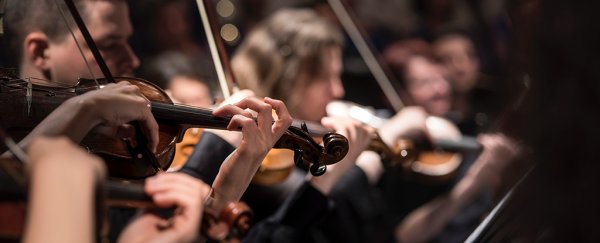It's not hard to feel a connection between musicians, the music being played, and the audience at any gig or concert that you go to, but new research suggests this link goes right down to the neural level – and that the brain activity of performers and listeners actually sync up.
Based on this new evidence, it also seems that the popularity of a piece of music is linked to how well brain patterns sync up as well, perhaps suggesting this is one of the ways our minds start to appreciate a good song.
While previous research has looked in detail at the way the brain responds to and enjoys music, we know much less about the neural connection between performers and audience members, something that this study tackles head on.
"Music appreciation involves the brains of music producers and perceivers in a temporally aligned network through which audiences perceive the intentions of the performer and show positive emotions related to the musical performance," the researchers write in their new paper.
Using near-infrared spectroscopy scans to monitor blood flow using light, the researchers analysed the brains of a professional violinist as he played brief 100-second clips of music. The same technique was used to monitor 16 audience members as they watched the clips being played back.
Inter-brain coherence between performer and listener was consistent and significant across all the test subjects, the results showed, with the same heightened activity being seen in the same specific parts of the brain as the clips were shown.
The brain regions involved include the left temporal cortex, which is linked to processing the rhythm of sounds, as well as the right inferior frontal cortex and the postcentral cortices – those second two areas are thought to help in social processes, enabling the brain to imagine 'walking in someone else's shoes'.
There was another noticeable correlation too, between how well liked a piece of music was on average (as rated by the listeners) and a stronger level of inter-brain coherence, with the audience as a whole, in the left temporal cortex.
This link only showed up during the second half of the clips, hinting that it takes time for music appreciation to develop; recognising rhythm and structure comes first, with aesthetic approval coming later on.
While this is a small study that doesn't record brain waves in great detail, its findings could be interesting prompts for future research, and it does tie in with what scientists have previously discovered – that music connects with the brain in a profound way.
We've also seen a similar sort of brain syncing happening between parents and babies, and between two people having a conversation. The next time you're watching your favourite band, you might be making more of a connection than you think.
"This study expands our understanding of music appreciation," conclude the researchers in their paper.
"These findings suggest that neural synchronisation between the audience and the performer might serve as an underlying mechanism for the positive reception of musical performance."
The research has been published in NeuroImage.
